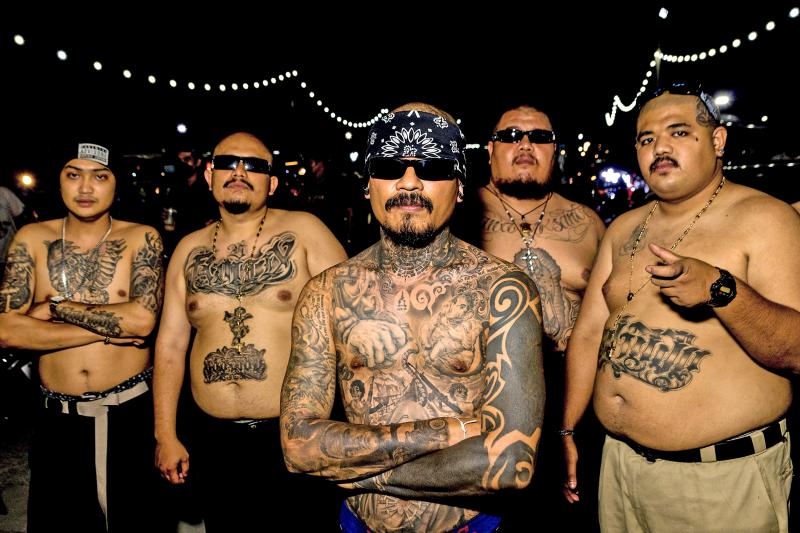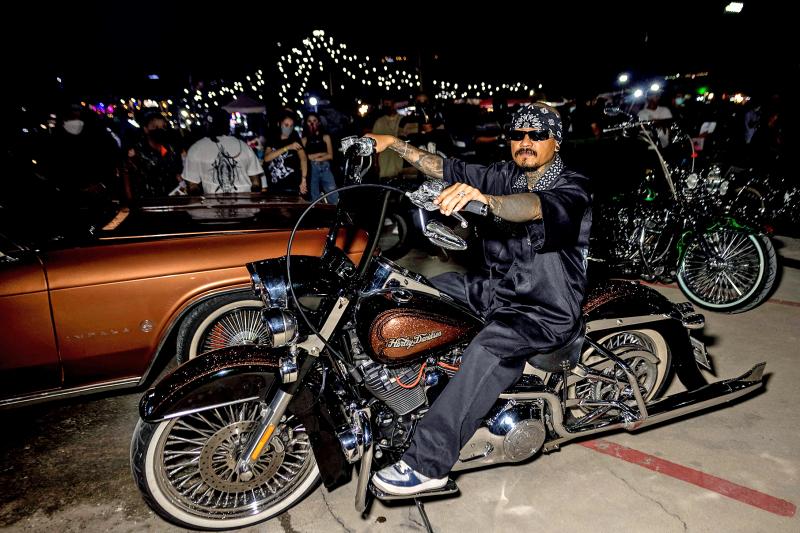The crowd roars in the tightly packed room as the broad-shouldered, tattooed men stop pummeling a young recruit and smother him with hugs — completing his initiation into one of Thailand’s “Chicano” gangs.
For the tight-knit group of friends, the ritual embodies a concept of a Mexican-American Chicano culture increasingly embraced in Asia, with sounds, styles and swagger from the US finding a home first in Japan, and now Thailand.
Dressed in baggy T-shirts and jeans, with bandanas and wraparound sunglasses only partially obscuring their intricate tattoos, Thais can now be seen on Bangkok’s sweaty streets celebrating a fusion of their own and Chicano culture each weekend.

Photo: AFP
But while the Chicano movement in the US began as a political and social force aimed at battling oppression, its Thai interpretation is focused more on its aesthetics.
“I just want to combine a Thai touch with the Chicano style to make this lifestyle simple and accessible,” explained gang leader Chalakorn “Leng” Arttanasiri, dismounting from his Harley Davidson.
Dragging on a smoke, the 40-year-old — who has images of the Virgin Mary, a Mayan goddess and much of “The Godfather” cast tattooed across his body — said his “Barbarian Has a Gun 13” group celebrates Chicano clothing and tattoos.

Photo: AFP
Its members say they are drawing on shared blue-collar values to create a blended “Thaino” culture, leaving their Chicano selves behind during the working week.
“On normal days, we dress like normal people,” Leng said, “but on the day of the gathering like this, we need to have options for our clothing so that we could look sharp and rock the same style as the others.”
A former drug-dealer, he grew up in a slum and served time but turned his life around running a business importing Chicano clothes, which prompted him to create a group to celebrate the culture.
But he has no time for the violence often associated with Chicanos by Hollywood — despite the tough initiation.
“It’s just a way to test their will,” he explained of the 13-second ordeal recruits endure to join his group.
“We can’t go around beating up other gangs to show our superiority,” he said. “We live in peace because we’re in a Buddhist-based city. We’re in Thailand.”
‘LAW-ABIDING CITIZENS’
“We’re law-abiding citizens who just love the Chicano subculture,” said Pongtep Singto, a lowrider car aficionado.
The 32-year-old was drawn to the scene’s low-slung, streamlined cars, collecting and customising the vehicles, and eventually building his own.
“Everybody has an honest career. Some of them may have tattoos all over their bodies but they’re all good people,” he added.
At a recent gathering, heavily tattooed men happily chatted as their children played in the background.
Among them was new recruit Chaiya Nob, who explained how gang “seniors” — only 13 of whom are permitted to have the group’s name dramatically emblazoned across their bellies — assessed him before he was allowed to join.
“Dressing like this doesn’t mean we have to act all macho, act like gangsters, and do illegal stuff,” the 31-year-old said.
“We have to do good and be respectable citizens. Our clothing choices may not be appropriate but our attitude is approachable,” he added with a grin.
Ultimately, the gang is about celebrating Chicano subculture together. As Leng puts it: “We’re family.”

This month the government ordered a one-year block of Xiaohongshu (小紅書) or Rednote, a Chinese social media platform with more than 3 million users in Taiwan. The government pointed to widespread fraud activity on the platform, along with cybersecurity failures. Officials said that they had reached out to the company and asked it to change. However, they received no response. The pro-China parties, the Chinese Nationalist Party (KMT) and Taiwan People’s Party (TPP), immediately swung into action, denouncing the ban as an attack on free speech. This “free speech” claim was then echoed by the People’s Republic of China (PRC),

Exceptions to the rule are sometimes revealing. For a brief few years, there was an emerging ideological split between the Democratic Progressive Party (DPP) and Chinese Nationalist Party (KMT) that appeared to be pushing the DPP in a direction that would be considered more liberal, and the KMT more conservative. In the previous column, “The KMT-DPP’s bureaucrat-led developmental state” (Dec. 11, page 12), we examined how Taiwan’s democratic system developed, and how both the two main parties largely accepted a similar consensus on how Taiwan should be run domestically and did not split along the left-right lines more familiar in

As I finally slid into the warm embrace of the hot, clifftop pool, it was a serene moment of reflection. The sound of the river reflected off the cave walls, the white of our camping lights reflected off the dark, shimmering surface of the water, and I reflected on how fortunate I was to be here. After all, the beautiful walk through narrow canyons that had brought us here had been inaccessible for five years — and will be again soon. The day had started at the Huisun Forest Area (惠蓀林場), at the end of Nantou County Route 80, north and east

Specialty sandwiches loaded with the contents of an entire charcuterie board, overflowing with sauces, creams and all manner of creative add-ons, is perhaps one of the biggest global food trends of this year. From London to New York, lines form down the block for mortadella, burrata, pistachio and more stuffed between slices of fresh sourdough, rye or focaccia. To try the trend in Taipei, Munchies Mafia is for sure the spot — could this be the best sandwich in town? Carlos from Spain and Sergio from Mexico opened this spot just seven months ago. The two met working in the